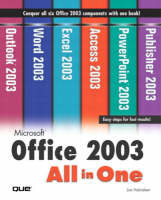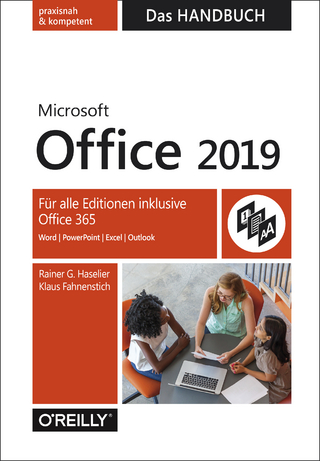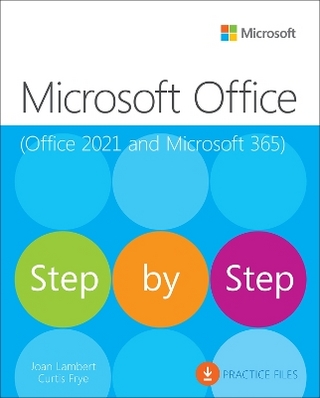
Microsoft Office 2003 All-in-One
Que Corporation,U.S. (Verlag)
978-0-7897-2936-1 (ISBN)
- Titel ist leider vergriffen;
keine Neuauflage - Artikel merken
Learn to use the core Office applications, Web integration, and Windows XP quickly with ten manageable mini-books in one! Microsoft Office 2003 All-in-One is a step-by-step hands-on tutorial broken down into short, easily digestible lessons. It not only provides basic information on the Office applications, but also goes beyond that by offering some intermediate coverage as well. It's an affordable and valuable means for learning the core Office components (Word, Excel, PowerPoint, Access, and Outlook), and also Windows XP, Web integration, and Internet Explorer.
Joe Habraken is a best-selling author, information technology professional, and educator. He is currently an assistant professor at the University of New England, where he teaches a variety of information technology classes introducing undergraduate students to computer basics, software applications, Web design, and the use of personal computers in business settings. His books include the Absolute Beginner's Guide to Networking (4th Edition), Practical Cisco Routers, and Sams Teach Yourself Microsoft Server 2003 in 24 Hours. With more than 15 years as a trainer and consultant, Joe, who is a Microsoft Certified Professional and a Cisco Certified Network Associate, enjoys taking difficult computer concepts and making them accessible to readers and students.
Introduction.
Using This Book. Conventions Used in This Book.
I. OFFICE INTRODUCTION AND SHARED FEATURES.
1. What's New in Office 2003?
Introducing Microsoft Office 2003. Office 2003 and the Document Workspace. Getting Help in Office 2003. Using the New Research Feature. Faxing over the Internet. Office 2003 and XML Data. Office Instant Messaging.
2. Using Common Office Features.
Starting Office Applications. Using the Menu System. Using Shortcut Menus. Working with Toolbars. Understanding Dialog Boxes.
3. Using Office Task Panes.
Understanding the Task Pane. The Research Task Pane. The Basic File Search Task Pane. Other Standard Task Panes.
4. Using the Office Speech Feature.
Training the Speech Feature. Using Voice Dictation. Using Voice Commands. A Final Word About the Speech Feature.
5. Getting Help in Microsoft Office.
Help: What's Available? Using the Ask a Question Box. Using the Office Assistant. Using the Help Task Pane. Searching For Help Online.
6. Customizing Your Office Applications.
Navigating Options Settings. Setting Options in Word. Setting Options in Excel. Setting Options in PowerPoint. Setting Special Options in Access. Customizing Toolbars.
7. Using Office Web Integration Features.
Adding Hyperlinks to Office Documents. Saving Office Documents As Web Pages. Adding an FTP Site to Your Save In Box.
8. Faxing and E-Mailing in Office 2003.
Understanding E-Mails and Faxes in Office. Using the Word Fax Wizard. Sending Faxes from Other Office Applications. Sending E-Mails from Office Applications.
II. MIGRATING TO OFFICE 2003.
1. Upgrading to Outlook 2003.
What's New in Outlook 2003? Using the New Navigation Pane. Creating Search Folders. Introducing the Business Contact Manager. Importing E-Mail Accounts and Other Data.
2. Upgrading to Word 2003.
What's New in Word 2003? Understanding File Format Issues. Word and XML Documents. Task Panes and Smart Tags.
3. Upgrading to Excel 2003.
Introducing Excel 2002. Creating Worksheet Lists. Comparing Worksheets Side by Side.
4. Upgrading to Access 2003.
What's New in Access 2003? Access File Format Issues. Access Error Checking. Backing Up an Access Database.
5. Upgrading to PowerPoint 2003.
What's New in PowerPoint 2003? PowerPoint File Format Issues. Packaging a Presentation to a CD.
6. Upgrading to Publisher 2003.
What's New in Publisher 2003? Creating E-Mail Publications. Publisher File Format Issues.
III. OUTLOOK.
1. Getting Started in Outlook.
Starting Outlook. Understanding the Outlook Window. Using the Mouse in Outlook. Working Offline. Exiting Outlook.
2. Understanding the Outlook E-Mail Configurations.
Types of Outlook E-Mail Configurations. Adding Other Types of E-Mail Accounts. Deleting or Changing E-Mail Accounts.
3. Using Outlook's Tools.
Using the Navigation Pane. Using the Folder List. Using the Advanced Toolbar. Creating Custom Views. Using Outlook Today.
4. Creating Mail.
Composing a Message. Formatting Text. Selecting the E-mail Message Format. Checking Spelling. Adding a Signature. Sending Mail. Recalling a Message.
5. Working with Received Mail.
Reading Mail. Saving an Attachment. Answering Mail. Printing Mail.
6. Managing Mail.
Deleting Mail. Forwarding Mail. Creating Folders. Moving and Copying Items to Another Folder.
7. Attaching Files and Items to a Message.
Attaching a File. Attaching Outlook Items.
8. Saving Drafts and Organizing Messages.
Saving a Draft. Viewing Sent Items and Changing Defaults. Using the Organize Tool. Creating Rules. Using the Junk E-Mail Filter.
9. Setting Mail Options.
Working with Message Options. Using Message Flags.
10. Using the Outlook Address Books.
Understanding the Outlook Address Books. Using the Address Book. Importing Address Books and Contact Lists. Exporting Outlook Address Records.
11. Creating a Contacts List.
Creating a New Contact. Viewing the Contacts List. Viewing a Contacts Activities Tab. Using Distribution Lists. Communicating with a Contact.
12. Using the Calendar.
Navigating the Calendar. Creating an Appointment. Scheduling a Recurring Appointment. Planning Events.
13. Planning a Meeting.
Scheduling a Meeting. Working Out Meeting Details. Editing Meeting Details and Adding Attendees. Responding to Meeting Requests.
14. Creating a Task List.
Entering a Task. Creating a Recurring Task. Assigning Tasks to Others. Viewing Tasks. Managing Tasks. Recording Statistics about a Task. Tracking Tasks.
15. Using the Journal.
Creating a Journal Entry. Viewing Journal Entries.
16. Using Outlook Notes.
Creating Notes. Setting Note Options. Managing Individual Notes. Viewing Notes.
17. Printing in Outlook.
Choosing Page Setup. Previewing Before Printing. Printing Items. Printing Labels and Envelopes. Setting Printer Properties.
18. Saving and Finding Outlook Items.
Using the Outlook Save As Feature. Finding Items. Using the Advanced Find Feature. Using Search Folders.
19. Archiving Items.
Using AutoArchive. Archiving Manually. Retrieving Archived Files.
20. Customizing Outlook.
Setting Outlook Options. Setting E-Mail Options. Setting Calendar Options. Other Options Dialog Box Tabs.
21. Introducing the Business Contact Manager.
Understanding the Business Contact Manager. Creating Business Contacts. Creating Accounts. Adding Contacts to Accounts. Linking Items to Accounts.
22. Creating Business Contact Manager Opportunities and Reports.
Creating Opportunities in Business Contact Manager. Creating Reports.
IV. WORD.
1. Working in Word.
Starting Word. Understanding the Word Environment. Using Menus and Toolbars. Exiting Word.
2. Working with Documents.
Starting a New Document. Entering Text. Saving a Document. Closing a Document. Opening a Document.
3. Editing Documents.
Adding or Replacing Text and Moving in the Document. Selecting Text. Deleting, Copying, and Moving Text. Copying and Moving Text between Documents.
4. Using Proofreading and Research Tools.
Proofing As You Type. Using the Spelling and Grammar Checker. Finding Synonyms Using the Thesaurus. Adding Research Services. Working with AutoCorrect.
5. Changing How Text Looks.
Understanding Fonts. Changing Font Attributes. Working in the Font Dialog Box. Aligning Text. Aligning Text with Click and Type. Automatically Detecting Formatting Inconsistencies. Reveal Formatting.
6. Using Borders and Colors.
Adding Borders in Word. Placing a Border around a Page. Adding Shading to the Paragraph. Changing Font Colors.
7. Working with Tabs and Indents.
Aligning Text Using Tabs. Working with Indents.
8. Examining Your Documents in Different Views.
Changing the Document Display. Using the Full Screen View. Zooming In and Out on Your Document. Working with the Document Map. Splitting the Document Window. Comparing Documents Side by Side.
9. Working with Margins, Pages, and Line Spacing.
Setting Margins. Controlling Paper Types and Orientation. Inserting Page Breaks. Changing Line Spacing.
10. Working with Styles.
Understanding Styles and the Style Task Pane. Creating Character Styles. Creating Paragraph Styles. Editing Styles. Using the Style Organizer.
11. Using AutoFormatting to Change Text Attributes.
Understanding AutoFormatting. Formatting As You Type. Applying AutoFormat to a Document. Changing AutoFormat Options.
12. Adding Document Text with AutoText and Using Special Characters.
Understanding AutoText. Using Special Characters and Symbols.
13. Adding Headers, Footers, and Page Numbers.
Understanding Headers and Footers. Adding Headers and Footers. Using Odd- and Even-Numbered Page Headers and Footers. Adding Page Numbering to a Document.
14. Printing Documents.
Sending Your Document to the Printer. Changing Print Settings. Selecting Paper Trays, Draft Quality, and Other Options.
15. Creating Numbered and Bulleted Lists.
Understanding Numbered and Bulleted Lists. Creating a Numbered or a Bulleted List. Adding Items to the List. Creating a Numbered or a Bulleted List from Existing Text. Creating Multilevel Lists.
16. Using Word Tables.
Understanding Tables and Cells. Creating Tables. Entering Text and Navigating in a Table. Inserting and Deleting Rows and Columns. Formatting a Table. Placing a Formula in a Table.
17. Creating Columns in a Document.
Understanding Word Columns. Creating Columns. Editing Column Settings.
18. Adding Graphics to Documents.
Inserting a Graphic. Using the Word Clip Art. Modifying Graphics. Using the Word Drawing Toolbar.
19. Creating Personalized Mass Mailings.
Understanding the Mail Merge Feature. Specifying the Main Document. Creating or Obtaining the Data Source. Completing the Main Document and Inserting the Merge Fields. Merging the Documents. Creating Envelopes and Mailing Labels.
20. Working with Larger Documents.
Adding Sections to Documents. Creating a Table of Contents.
21. Creating Web Pages in Word.
Using Word to Create Web Pages. Selecting a Theme for Your Web Page. Adding Hyperlinks to a Document. Previewing Your Web Pages.
V. EXCEL.
1. Creating a New Workbook.
Starting Excel. Understanding the Excel Window. Starting a New Workbook. Saving and Naming a Workbook. Saving a Workbook Under a New Name or Location. Opening an Existing Workbook. Closing Workbooks. Exiting Excel.
2. Entering Data into the Worksheet.
Understanding Excel Data Types. Entering Text. Entering Numbers. Entering Dates and Times. Copying Data to Other Cells. Taking Advantage of AutoComplete.
3. Performing Simple Calculations.
Understanding Excel Formulas. Entering Formulas. Using the Status Bar AutoCalculate Feature. Displaying Formulas. Editing Formulas.
4. Manipulating Formulas and Understanding Cell References.
Copying Formulas. Using Relative and Absolute Cell Addresses. Recalculating the Worksheet.
5. Performing Calculations with Functions.
What Are Functions? Using the Insert Function Feature.
6. Getting Around in Excel.
Moving from Worksheet to Worksheet. Switching Between Workbooks. Moving Within a Worksheet.
7. Different Ways to View Your Worksheet.
Changing the Worksheet View. Freezing Column and Row Labels. Splitting Worksheets. Hiding Workbooks, Worksheets, Columns, and Rows. Locking Cells in a Worksheet.
8. Editing Worksheets.
Correcting Data. Undoing an Action. Using the Replace Feature. Checking Your Spelling. Copying and Moving Data. Using the Office Clipboard. Deleting Data.
9. Changing How Numbers and Text Look.
Formatting Text and Numbers. Using the Style Buttons to Format Numbers. Numeric Formatting Options. How You Can Make Text Look Different. Changing Text Attributes with Toolbar Buttons. Accessing Different Font Attributes. Aligning Text in Cells. Copying Formats with Format Painter.
10. Adding Cell Borders and Shading.
Adding Borders to Cells. Adding Shading to Cells. Using AutoFormat. Applying Conditional Formatting.
11. Working with Ranges.
What Is a Range? Selecting a Range. Naming Ranges. Creating Range Names from Worksheet Labels. Inserting a Range Name into a Formula or Function.
12. Inserting and Removing Cells, Rows, and Columns.
Inserting Rows and Columns. Removing Rows and Columns. Inserting Cells. Removing Cells. Adjusting Column Width and Row Height with a Mouse. Using the Format Menu for Precise Control.
13. Managing Your Worksheets.
Selecting Worksheets. Inserting Worksheets. Deleting Worksheets. Moving and Copying Worksheets. Changing Worksheet Tab Names.
14. Printing Your Workbook.
Previewing a Print Job. Changing the Page Setup. Printing Your Workbook. Selecting a Large Worksheet Print Area. Adjusting Page Breaks.
15. Creating Charts.
Understanding Charting Terminology. Working with Different Chart Types. Creating and Saving a Chart. Moving and Resizing a Chart. Printing a Chart.
VI. ACCESS.
1. Working in Access.
Starting Access. Parts of the Access Window. Exiting Access. Understanding Access Databases and Objects. Planning a Database.
2. Creating a New Database.
Choosing How to Create Your Database. Opening a Database. Closing a Database.
3. Creating a Table with the Table Wizard.
Tables Are Essential. Working with the Table Wizard.
4. Creating a Table from Scratch.
Creating Tables Without the Wizard. Creating a Table in Table Design View. Creating a Table in the Datasheet View.
5. Editing a Table's Structure.
Editing Fields and Their Properties. Adding, Deleting, and Moving Fields. Deleting a Table.
6. Entering Data into a Table.
Entering a Record. Moving Around in a Table. Hiding a Field. Freezing a Column. Using the Spelling Feature. Closing a Table.
7. Editing Data in a Table.
Changing a Field's Content. Moving and Copying Data. Inserting and Deleting Fields. Inserting New Records. Deleting Records.
8. Formatting Access Tables.
Changing the Look of Your Table. Changing Column Width and Row Height. Changing the Font and Font Size.
9. Creating Relationships between Tables.
Understanding Table Relationships. Creating a Relationship between Tables. Enforcing Referential Integrity. Editing a Relationship. Removing a Relationship.
10. Creating a Simple Form.
Creating Forms. Creating a Form with AutoForm. Creating a Form with the Form Wizard. Creating a Form from Scratch. Entering Data into a Form.
11. Modifying a Form.
Working with Field Controls. Viewing Headers and Footers. Adding Labels. Formatting Text on a Form. Changing Tab Order.
12. Adding Special Controls to Forms.
Using Special Form Controls. Creating a List Box or a Combo Box. Creating an Option Group. Adding Command Buttons.
13. Searching for Information in Your Database.
Using the Find Feature. Using the Replace Feature.
14. Sorting, Filtering, and Indexing Data.
Sorting Data. Filtering Data. Indexing Data.
15. Creating a Simple Query.
Understanding Queries. Using the Simple Query Wizard. Using Other Query Wizards. Understanding Access Query Types.
16. Creating Queries from Scratch.
Introducing Query Design View. Adding Fields to a Query. Deleting a Field. Adding Criteria. Using the Total Row in a Query. Viewing Query Results.
17. Creating a Simple Report.
Understanding Reports. Using AutoReport to Create a Report. Creating a Report with the Report Wizard. Viewing and Printing Reports in Print Preview.
18. Customizing a Report.
Working in the Report Design View. Working with Controls on Your Report. Placing a Calculation in the Report.
19. Taking Advantage of Database Relationships.
Reviewing Table Relationships. Viewing Related Records in the Datasheet View. Creating Multi-Table Queries. Creating Multi-Table Forms. Creating Multi-Table Reports.
20. Printing Access Objects.
Access Objects and the Printed Page. Printing Reports. Printing Other Database Objects. Using the Print Dialog Box.
VII. POWERPOINT.
1. Working in PowerPoint.
Starting PowerPoint. Getting Comfortable with the PowerPoint Window. Exiting PowerPoint.
2. Creating a New Presentation.
Starting a New Presentation. Saving a Presentation. Closing a Presentation. Opening a Presentation. Finding a Presentation File.
3. Working with Slides in Different Views.
Understanding PowerPoint's Different Views. Moving from Slide to Slide. Introduction to Inserting Slide Text. Editing Text in the Slide Pane.
4. Changing a Presentation's Look.
Giving Your Slides a Professional Look. Applying a Different Design Template. Using Color Schemes. Changing the Background Fill.
5. Inserting, Deleting, and Copying Slides.
Inserting Slides into a Presentation. Creating Slides from a Document Outline. Deleting Slides. Cutting, Copying, and Pasting Slides.
6. Rearranging Slides in a Presentation.
Rearranging Slides in Slide Sorter View. Rearranging Slides in the Outline Pane. Hiding Slides.
7. Adding and Modifying Slide Text.
Creating a Text Box. Changing Font Attributes. Copying Text Formats. Changing the Text Alignment and Line Spacing. Adding a WordArt Object.
8. Creating Columns, Tables, and Lists.
Working in Multiple Columns. Making a Bulleted List. Working with Numbered Lists.
9. Adding Graphics to a Slide.
Using the Clip Art Task Pane. Inserting an Image from the Task Pane. Inserting an Image from an Image Box. Inserting a Clip from a File. Managing Images in the Clip Organizer.
10. Adding Sounds and Movies to a Slide.
Working with Sounds and Movies. Including Sounds in a Presentation. Placing a Movie onto a Slide.
11. Working with PowerPoint Objects.
Selecting Objects. Working with Layers of Objects. Grouping and Ungrouping Objects. Cutting, Copying, and Pasting Objects. Rotating an Object. Resizing Objects. Cropping a Picture.
12. Presenting an Onscreen Slide Show.
Viewing an Onscreen Slide Show. Setting Slide Animation Schemes. Setting Up a Self-Running Show. Using the Slide Show Menu Tools. Adding Action Buttons to User-Interactive Shows. Setting Slide Show Options.
13. Printing Presentations, Notes, and Handouts.
Using PowerPoint Notes and Handouts. Quick Printing with No Options. Changing the Page Setup. Choosing What and How to Print.
VIII. PUBLISHER.
1. Getting Started with Publisher.
Starting Publisher. Deciding How to Create a New Publication. Using the Publisher Workspace. Exiting Publisher.
2. Creating a New Publication.
Using a Publication Category. Saving Your Publication.
3. Using Design Sets.
Understanding the Publication Design Sets. Selecting the Design Set. Completing the Publication. Creating a Publication from Scratch.
4. Viewing Your Publications.
Changing the Publication Display. Using the Zoom Feature. Working with Rulers and Guide Lines.
5. Working with Existing Publications.
Opening an Existing Publication. Completing a Design Template Publication. Adding Pages to a Publication. Saving a Revised Publication Under a New Name. Closing a Publication.
6. Working with Publication Objects.
Inserting an Object. Sizing an Object Frame. Moving an Object. Copying an Object. Grouping Objects. Arranging Objects in Layers. Adding Border and Colors to Object Frames.
7. Changing How Text Looks.
Adding Text to Your Publications. Working with Fonts. Changing Font Attributes. Changing Font Colors. Aligning Text in a Text Box. Adding Tables to a Publication.
8. Working with Graphics.
Inserting a Picture. Using Clip Art. Cropping Pictures. Drawing Objects.
9. Formatting Publication Pages.
Changing Page Margins. Adding Page Borders. Working with Master Pages.
10. Fine-Tuning Publisher Publications.
Using the Spell Checker. Controlling Hyphenation in Text Boxes. Using the Design Checker. Setting Up AutoCorrect.
11. Printing Publisher Publications.
Previewing the Publication. Printing the Publication. Working with Print Options. Using Pack and Go.
Index.
| Erscheint lt. Verlag | 6.11.2003 |
|---|---|
| Sprache | englisch |
| Maße | 186 x 231 mm |
| Gewicht | 1566 g |
| Themenwelt | Informatik ► Office Programme ► Office |
| ISBN-10 | 0-7897-2936-9 / 0789729369 |
| ISBN-13 | 978-0-7897-2936-1 / 9780789729361 |
| Zustand | Neuware |
| Informationen gemäß Produktsicherheitsverordnung (GPSR) | |
| Haben Sie eine Frage zum Produkt? |
aus dem Bereich


